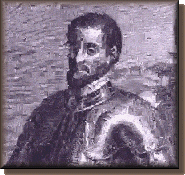

The first recorded European contact with the Cherokee was Hernando De Soto's expedition of 1540. Records of the expedition refer to the tribe as "Chalaque", probably from the Mobilian trade language (a corrupted Choctaw jargon used by the tribes of the Southeast), probably meaning "cave people".  This word in the southern Cherokee dialect was pronounced "Tsa-la-gi" but in the eastern area pronounced "Tsa-ra-gi", from which the name "Cherokee" is derived. The Cherokee called themselves "Ani-Yun-wiya", the principal people. The Cherokee also referred to themselves as "Ani-Kituhwagi", the
people of Kituhwa -- an ancient town which was probably the original nucleus of the tribe.
This word in the southern Cherokee dialect was pronounced "Tsa-la-gi" but in the eastern area pronounced "Tsa-ra-gi", from which the name "Cherokee" is derived. The Cherokee called themselves "Ani-Yun-wiya", the principal people. The Cherokee also referred to themselves as "Ani-Kituhwagi", the
people of Kituhwa -- an ancient town which was probably the original nucleus of the tribe.
In April of 1540, De Soto crossed through the Cherokee country looking for gold. The Spanish explorers found the first Cherokee village they encountered practically deserted.  The Cherokee were aware of the outrageous conduct of the Spaniards toward neighboring tribes so they abandoned their towns before the arrival of the expedition, leaving behind only those who could not travel. In need of food and receiving no help from the Cherokee, the expedition quickly moved on to the north.
The Cherokee were aware of the outrageous conduct of the Spaniards toward neighboring tribes so they abandoned their towns before the arrival of the expedition, leaving behind only those who could not travel. In need of food and receiving no help from the Cherokee, the expedition quickly moved on to the north.
Turning to the west, across the Blue Ridge, De Soto again entered the Cherokee country and received a much warmer welcome. The Cherokee were reportedly very hospitable and provided the travelers with much needed food -- corn, wild turkey, and other small game.
De Soto moved on to the Muscogee, Creek, country but sent two soldiers back into the Cherokee country to look for reported copper and gold mines. One report states that they found mines of a fine species of copper with indications of gold and silver but De Soto chose not to return to search for the mines.
 The two soldiers were given a dressed buffalo skin, the first obtained by white men, and described it as "an ox hide as thin as a calf's skin, and the hair like a soft wool between the coarse and fine wool of sheep." It should be noted that buffalo (actually the correct name is "bison") did not just roam the "Great Plains" but could be found all the way to the Atlantic Coast.
The two soldiers were given a dressed buffalo skin, the first obtained by white men, and described it as "an ox hide as thin as a calf's skin, and the hair like a soft wool between the coarse and fine wool of sheep." It should be noted that buffalo (actually the correct name is "bison") did not just roam the "Great Plains" but could be found all the way to the Atlantic Coast.
The next reported contact with Europeans came in the fall of 1566. The Spanish had established Fort San Felipe near present Port Royal, SC and a small expedition was sent into the interior of the region. Joined the following summer by another detachment of troops, the combined force returned to their fort. Most reports were that they received a friendly reception everywhere along the their route.
The Spanish carried on mining and smelting of gold and other metals within the Cherokee country in the mid to late 1600's. Although these operations were kept secret by the Spanish, they were well known in the Spanish settlements of Santa Elena and Saint Augustine.